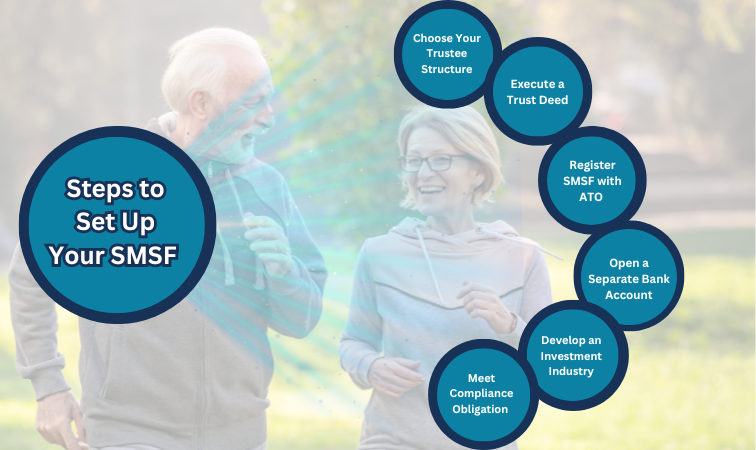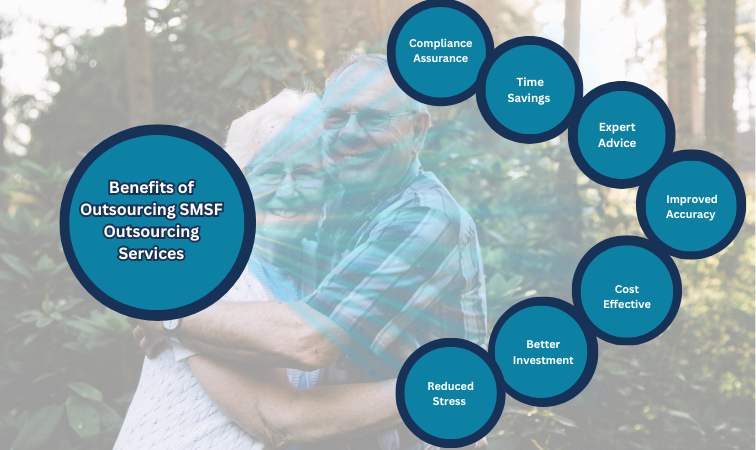
GET A FREE CONSULTATION TODAY!
Fill in the details, and our experts will contact you.
A Self-Managed Super Fund (SMSF) is an increasingly popular retirement savings option in Australia. It allows people to take control of their superannuation investments. However, setting up SMSF services and managing them requires compliance with strict regulations and ongoing compliance.
Several key regulatory changes will be introduced in 2025, impacting how SMSFs are established and managed. Whether you're a first-time SMSF trustee or considering transitioning from a retail or industry super fund, here’s everything you need to know about setting up SMSF administration services in 2025.
A self-managed super fund (SMSF) is a private super fund that you manage yourself. Members who act as trustees make a Self-Managed Super Fund (SMSF) their superannuation fund. The fund management authority of trustees consists of maintaining the fund according to Australian superannuation regulations and performing investment choices. SMSFs differ from retail and industry super funds by granting members better control of their investments to develop investment portfolios according to their individual risk capacity and financial targets.
Investment freedom for super funds extends beyond traditional manager-directed assets because trustees can buy property, shares, and collectables together. The freedom to manage an SMSF requires trustees to have a major responsibility related to the legal duties and administrative tasks needed to operate a fund that meets Australian Taxation Office standards.
The Australian Taxation Office has implemented a lot of updates related to SMSF in Australia. Some of the major changes are as follows:
Tax Changes for Large Superannuation Balances: The government is considering increasing taxes on large super balances in Australia related to SMSF. To pass, the government needs support from minor parties and independent senators. However, many oppose the plan's key parts, like taxing unrealised gains and not adjusting the $3 million threshold over time.
With a federal election approaching, it’s unclear whether this tax change will proceed. It may be delayed or scrapped altogether if it doesn't pass soon.
Higher Contribution Caps: To account for inflation and changing economic conditions, the government increased concessional and non-concessional contribution caps on July 1, 2025. This means SMSF members can contribute more to their retirement savings with favourable tax advantages.
However, on 1 July 2025, the transfer balance cap (TBC)—which limits how much super fund can be transferred into a retirement pension—will increase from $1.9 million to $2 million.
This change mainly affects people who haven’t started drawing a retirement income from their super. If you already receive a pension from your super, you might still benefit from a partial increase, depending on your circumstances.
Stricter Trustee Education Requirements: A major change in 2025 is the introduction of mandatory trustee education. Before setting up an SMSF, new trustees must complete an ATO-approved SMSF compliance course. This ensures they understand their legal responsibilities and follow all the major obligations.
Real-Time Reporting for SMSFs: The ATO has expanded real-time reporting requirements, requiring electronic lodgements of financial statements and contributions. Technology plays a more significant role in superannuation, and 2025 will likely see more innovation.
Super funds are investing in better online tools, mobile apps, and artificial intelligence to help members track their savings and make smarter investment choices. If you haven’t already, it’s worth exploring your super fund’s digital tools to take control of your retirement planning.
Changes to Property Investments: A new restriction system will take effect in 2025 for SMSF property investments accessed through borrowing arrangements. Investments in property by funds must present sufficient cash flow capabilities and diversified assets that fulfil member retirement needs.
Enhanced Cybersecurity Measures: SMSFs must establish superior security measures because cyber attacks have increased which requires better protection for their member data along with financial transactions. The use of multi-factor authentication remains mandatory while trustees must securely maintain all sensitive financial data.
Follow Crucial Steps to Set Up Your SMSF

If we have set up your SMSF, it will have several steps, each requiring careful planning and execution. Here’s a step-by-step guide for you:
Step 1: Choose Your Trustee Structure: The selection of trustee structure involves choosing between individual trustees and corporate trustees. Your trust needs at least two individual trustees who become part of the trustee role. The fund members appointed as directors will work with the company to manage the trust functions as the trustee entity.
Organisations benefit from corporate trustee structures as this structure provides optimal asset protection benefits and a succession planning process.
Step 2: Execute a Trust Deed: The trust deed is a type of legal document outlining how the SMSF will be managed. It must follow the Superannuation Industry (Supervision) Act 1993 (SIS Act) and include investment guidelines, trustee responsibilities, and member benefits.
Step 3: Register the SMSF with the ATO: Once the trust deed is finalised, the SMSF must be registered with the ATO. You will need to:
Obtain an Australian Business Number (ABN) and Tax File Number (TFN).
Register for GST if the fund expects turnover exceeding $75,000.
Step 4: Open a Dedicated Bank Account: The SMSF should have a different bank account for receiving contributions and managing investments. It is strictly prohibited to personal and fund finances,
Step 5: Develop an Investment Strategy: SMSFs need to develop written investment strategies that evaluate member retirement goals and contracts with sole-purpose requirements and risk tolerance, diversification, and liquidity needs.
Risk tolerance and diversification
Liquidity needs
Member retirement objectives
SMSFs must ensure their funds serve only retirement benefits according to the sole purpose test.
Step 6: Meet Annual Compliance Obligations: SMSFs must meet ongoing compliance requirements, including:
Lodging an annual return
Undergoing an independent audit
Keeping up-to-date financial records

There are a lot of benefits of self managed super fund. Outsourcing your SMSF requirements can help you in many ways. It will save you time and maximise your investment returns. Here are the advantages of self managed super funds:
1. Compliance Assurance: A professional SMSF outsourcing service can help you stay updated with changing regulations according to ATO and ASIC requirements. Outsourcing companies can help you reduce the errors with SMSF and you don't have to face legal issues as well.
2. Time Savings: Managing an SMSF involves complex administrative tasks, from record-keeping to tax reporting. Outsourcing allows you to focus on strategic investment decisions while experts handle the paperwork.
3. Expert Advice: You can manage your SMSF with professional accountants, auditors, and financial advisers. If you outsource your SMSF outsourcing services then you will gain insights on investment strategies, tax minimisation and retirement planning.
4. Improved Accuracy and Reduced Errors: Outsourcing your SMSF help you with accurate reporting, reducing your mistakes in tax filings, and audits.
5. Cost-Effective: Outsourcing your SMSF can have associated costs, but it is more efficient for larger SMSFs. The benefits of expert management often reduce the expenses for funds with diverse investments.
6. Better Investment: Professional outsourcing service providers give you detailed performance tracking, helping you make informed decisions about asset allocation and risk management.
7. Reduced Stress: If you use outsourcing SMSF services, then you will get SMSF experts handling the complexities of SMSF administration, and you can have peace of mind knowing your retirement savings are being managed effectively.
Outsourcing self-managed super fund (SMSF) management will solve your retirement needs in 2025. The foundations for establishing an SMSF during 2025 are based on strategic preparation, regulatory adherence, and continuous compliance obligations. Maintaining awareness about updated news and real-time reporting of SMSF needs constant monitoring.
Taking the help of an outsourcing SMSF expert like Aone Outsourcing Solution can help you with better SMSF guidance and greater investment. They can help you understand if this retirement savings vehicle fits your financial plans. By planning your financial process correctly, you can achieve the best financial outcomes and mitigate potential risks, thus securing a comfortable retirement.
Special characters are not allowed.
Special characters are not allowed.